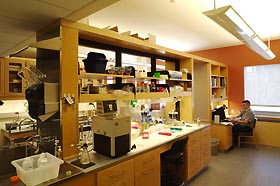|
This is an archived article.
For the latest news, go to the
Advance Homepage For more archives, go to the Advance Archive/Search Page. | ||
|
Biology/Physics Building
Open
Design Supports Research, Teaching By Richard Veilleux David Benson's long walks through the Torrey Life Sciences Building, trying to find colleagues in the Department of Molecular and Cell Biology who were scattered on different floors, have ended. Benson and his departmental colleagues, formerly dispersed in many areas of three different buildings, have moved into the new Biology/Physics Building on North Eagleville Road. UConn's tallest building at 110 feet, the structure will also house several physics professors in laboratories and offices on the building's ground floor, where they will conduct laser research. Members of the Department of Ecology and Evolutionary Biology will work in a rooftop greenhouse and will display and store collections on the first floor. The Biotechnology Center also will share the new building.
Dozens of research labs line two long hallways that merge above Auditorium Road, and two 150-seat classrooms jut off the side of the building onto the plaza level of the Edward V. Gant Science Complex. A series of bridges span a six-story atrium, connecting the research and office wings on one side of the building; and another, enclosed bridge connects the complex with the Torrey Life Sciences Building, scheduled to be renovated when the 21st Century UConn program begins. "It's a wonderful building. Facilities like this will help us recruit graduate students, post docs and faculty," says Benson, adding that the building's configuration promotes interaction, and the design's efficient use of lab space will increase productivity. Like other UConn 2000-financed academic buildings before it, including new chemistry, business, and liberal arts buildings, the Biology/Physics Building offers data jacks throughout the facility, and has audio-video capability in each of two 150-seat lecture halls and in every conference room and lounge. Also like the chemistry building, the laboratories and offices are located in separate wings. The space is climate-controlled, and the research wing can be entered only with key cards, preventing unauthorized use and providing a safety mechanism to keep students and visitors from entering areas containing hazardous materials. The 111,000-square-foot building includes a 22,000 square-foot physics addition for laser technology research. It also will become home to more than 125,000 specimens - birds, mammals, fish, parasites, and vascular plants among them - from the University's natural history collection. The collection, much of which has been held in storage or hidden from view in the outdated Torrey Life Sciences Building, will be filed in a more "user-friendly" manner: much of it will be displayed, and all of it will be accessible, says Les Mehrhoff, collection manager for the Department of Ecology and Evolutionary Biology. Philip Yeagle, head of the molecular and cell biology department, says the new building will give his faculty the equipment and laboratories they need to advance their research. "We'll be going from substandard research space to state-of-the-art," he says. "This will have a significant effect on our research programs, including those of several new faculty who came here - really bright young scientists - partly because of the space they were promised in this building." It also will enhance grants writing, says Michelle Barber, who operates and assists faculty and staff using the Flowcytometry and Confocal Microscopy Facility. "We had two rooms, located on different floors, in Torrey," says Barber. "The new building doubles our space." She says the new facility will increase productivity and offer the opportunity to expand, and hopes that will help win grants for more equipment. As soon as all the existing equipment and the remaining faculty and staff located in the Torrey Life Sciences Annex are moved into the new facility, the old structure will be razed, clearing the way for a 215,000-square-foot, $87 million pharmacy/ biology building. Site work on that structure, projected to open in 2005, has already begun. At another site, on Fairfield Way, workers are finishing work on the Information Technology Building, which will house the departments of computer sciences and electrical engineering. The main building is scheduled for completion by the end of January. An underground classroom connected to the building will be completed in mid-April. |

